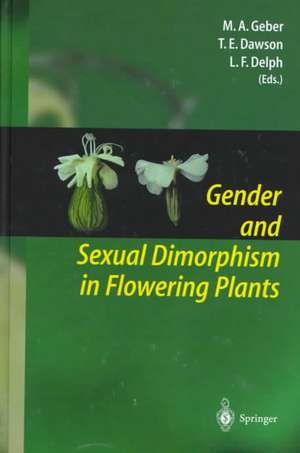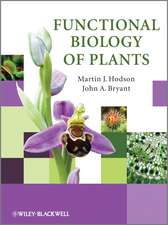Gender and Sexual Dimorphism in Flowering Plants
Editat de Monica A. Geber, Todd E. Dawson, Lynda F. Delphen Limba Engleză Hardback – 27 noi 1998
| Toate formatele și edițiile | Preț | Express |
|---|---|---|
| Paperback (1) | 389.88 lei 6-8 săpt. | |
| Springer Berlin, Heidelberg – dec 2010 | 389.88 lei 6-8 săpt. | |
| Hardback (1) | 397.59 lei 6-8 săpt. | |
| Springer Berlin, Heidelberg – 27 noi 1998 | 397.59 lei 6-8 săpt. |
Preț: 397.59 lei
Nou
Puncte Express: 596
Preț estimativ în valută:
76.08€ • 79.66$ • 63.10£
76.08€ • 79.66$ • 63.10£
Carte tipărită la comandă
Livrare economică 09-23 aprilie
Preluare comenzi: 021 569.72.76
Specificații
ISBN-13: 9783540645979
ISBN-10: 3540645977
Pagini: 332
Ilustrații: XX, 305 p.
Dimensiuni: 155 x 235 x 23 mm
Greutate: 0.64 kg
Ediția:1999
Editura: Springer Berlin, Heidelberg
Colecția Springer
Locul publicării:Berlin, Heidelberg, Germany
ISBN-10: 3540645977
Pagini: 332
Ilustrații: XX, 305 p.
Dimensiuni: 155 x 235 x 23 mm
Greutate: 0.64 kg
Ediția:1999
Editura: Springer Berlin, Heidelberg
Colecția Springer
Locul publicării:Berlin, Heidelberg, Germany
Public țintă
GraduateCuprins
1 Gender and Sexual Dimorphism in Flowering Plants: A Review of Terminology, Biogeographic patterns, Ecological Correlates, and Phylogenetic Approaches.- 1.1 Introduction.- 1.2 Terminology.- 1.3 Incidence of Dioecy.- 1.4 Importance of Phylogenetic Approaches.- 1.5 Using Phylogenies to Understand Process and Pattern.- 1.6 Conclusions.- References.- 2 Theories of the Evolution of Dioecy.- 2.1 Introduction.- 2.2 Importance of Theoretical Models.- 2.3 Pathways to Dioecy.- 2.4 Theoretical Relationships Between Allocation of Reproductive Resources and Invasion of Populations by New Sex Morphs.- 2.5 Testing the Theory.- 2.6 Conclusions.- 2.7 References.- 3 Empirical Studies: Evolution and Maintenance of Dimorphic Breeding Systems.- 3.1 Introduction.- 3.2 Evolutionary Pathways to Gender Dimorphism.- 3.3 Maintenance of Gender Dimorphism in Natural Populations.- 3.4 Directions for Future Research.- 3.5 Conclusions.- References.- 4 Theories of the Evolution of Sexual Dimorphism.- 4.1 Introduction.- 4.2 Models of Sexual Dimorphism.- 4.3 The Biology of Sexual Dimorphism.- 4.4 Conclusions.- References.- 5 Sexual Dimorphism in Flowers and Inflorescences.- 5.1 Introduction.- 5.2 Patterns.- 5.3 Evolutionary Hypotheses.- 5.4 Conclusions.- References.- 6 Sexual Dimorphism in Live History.- 6.1 Introduction.- 6.2 Predictions Based on Sex-Differential Reproductive Investment.- 6.3 Patterns of Sexual Dimorphism in Life-History Traits.- 6.4 Factors Offsetting Between-Sex Differences in the Cost of Reproduction.- 6.5 The Contrary Case of Silene latifolia.- 6.6 Conclusions.- References.- 7 Dimorphism in Physiology and Morphology.- 7.1 Introduction.- 7.2 History of Studies on Sexual Dimorphism in Plants.- 7.3 Sexual Dimorphism in Plant Form and Function in Species with SSS.- 7.4 Sexual Dimorphism in Plant Form and Function in Species Without SSS.- 7.5 Conclusions and Future Directions.- References.- 8 Sexual Dimorphism and Biotic Interactions.- 8.1 Introduction.- 8.2 Sexual Differences in Competitive Ability.- 8.3 Sexual Differences in Herbivory.- 8.4 Sexual Differences in Parasitism.- 8.5 General Discussion.- References.- 9 Genetics of Gender Dimorphism in Higher Plants.- 9.1 Introduction.- 9.2 Monoecious Plants.- 9.3 Multigenic gender determination systems in dioecious plants.- 9.4 Expression of MADS-box genes in unisexual flowers.- 9.5 Conclusions.- References.- 10 Quantitative Genetics of Sexual Dimorphism.- 10.1 Introduction.- 10.2 Quantitative Genetic Models of Sexual Dimorphism.- 10.3 Integration of Quantitative Genetics with Sexual Selection.- 10.4 Correlated Evolution and Divergence of Male and Female Traits in Dioecious Plants.- 10.5 Correlated Evolution and Divergence of Male and Female Function in Hermaphroditic Plants.- 10.6 Conclusions.- 10.7 References.- Taxonomic Index.
Textul de pe ultima copertă
This volume, which is written by the leading experts, consists of three sections: the first introduces readers to the tremendous variety of breeding systems and their evolution in plants and sets the stage for a consideration of the evolution of dimorphism in reproductive and non-reproductive characters. The second section deals with the evolution of secondary sexual characters, including the theory related to the evolution of sexual dimorphism and its empirical patterns. The last deals with the genetics of gender expression and of secondary sexual characters.
Caracteristici
The first comprehensive review of research on the evolution of gender dimorphism and dimorphism in secondary sex characters in plants Covers both recent advances and historical findings in theoretical and empirical studies Written by the leading experts on plant breeding system evolution






